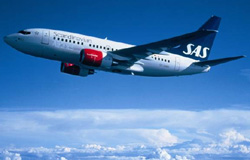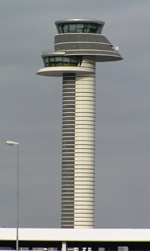A greener aircraft landing
on
A greener aircraft landing
A small but important step has been made towards more fuel efficient aviation with lower CO2 emissions and less noise pollution for people living near flight paths. Europe’s first “Green Curved Approach” has been flown at Stockholm’s Arlanda Airport.
 |
| Scandinavian airlines (SAS) plane just after take off from Arlanda airport |
In Sweden, a project has been started that focuses on a particular piece of the puzzle, namely the aircraft’s landing approach. The participants in this so-called MINT project (Minimum CO2 in Terminal Manoeuvring Area) are the Swedish Civil Aviation Authority (Luftfartsverket, LFV), the small but committed charter airline Novair, manufacturer Airbus, consultancy Egis Avia and project managers Avtech. They have adopted a method dubbed the “green curved approach”, which not only aims to make the approach and landing as fuel-efficient as possible (the “green” part) but also to reduce noise levels for people living near the airports (the “curved” part).
At Arlanda – Stockholm’s largest airport – all runways used for landing are to be prepared for the “green curved approach” during off-peak hours and in good weather conditions from 2012 on. It is not clear yet when other airports will be able to adopt the system. ‘That rather depends on the airport in question,’ says MINT project manager Christer Forsberg.
Noise relief
‘To the left you can see Upplands Väsby.’ Captain Henrik Ekstrand’s announcement refers to a suburb to the north of Stockholm, which normally lies directly under the flight path. He is flying an Airbus A321 on the tenth and last test flight in the series. After leaving its cruising altitude of 27,000 ft and adopting the approach course agreed with the control tower, the aircraft glides with minimum engine thrust (known as “gliding down idle”) towards its destination. En route, it swings to the right three times and once to the left, to avoid the most densely populated areas and a hospital. He misses his designated arrival time by less than two seconds.
“Green” approaches have been around for some years. Soon, aircraft will no longer be forced by the air traffic control tower to adopt various holding patterns (“step down approach”) before commencing their final approach or to circle for some time until the order comes to drop to the next level. It is becoming increasingly common to choose the shortest route, thus saving fuel and reducing CO2 emissions. In addition, and this is the new part: attempts are made to reduce noise pollution as far as possible for people who live near or below flight paths used for landing. ‘We will not get rid of the noise completely, but we can improve the lives of many people,’ asserts LRV spokesman Jan Lindqvist.
 |
| The charactaristic control tower of Arlanda airport. |
The “green curved approach” brings with it considerable environmental and financial advantages, the MINT test series has shown. Thanks to “gliding down idle”, it was possible to shorten flight routes by up to 19 NM (nautical miles) during the tests. 160 to 340 kg of fuel is saved per landing, reducing CO2 emissions by up to approximately 1,000 kg, about 38%, according to Avtech. Due to the greater punctuality achieved, scheduling can be done more accurately on the ground and more aircraft can be handled. The workload in the tower is reduced, with no significant increase in the workload for pilots. Fewer people living in densely populated residential areas close to the airport are disturbed by aircraft noise.
Single airspace
To be able to fly into Stockholm using the RNP approach, approval from the Transport Authority (transportstyrelsen) is required. It is anticipated that Novair and SAS will be the first airlines to hold such authorisation in 2010. However, it is not yet possible to transfer what has been demonstrated in recent months in Stockholm to other airports. The MINT partners describe the conditions in Stockholm as optimal. ‘We have only two to three hours of peak traffic here every day, while at Heathrow these levels persist 24 hours a day’, they say. The airspace is thus ‘relatively uncrowded’.
The cooperation on the project was praised on all sides. The LFV is well-known for its environmental credentials. It’s no coincidence that Arlanda was the first airport to be awarded ‘the highest possible accreditation status for its outstanding effort to lower its impact on climate change’ in the middle of 2009 by the Airport Council International (ACI, Europe). Arlanda has successfully reduced its CO2 emissions by 50% in the last three years. The remaining CO2 emissions, monitored by the LFV, are offset through its support of environmental projects in China and Costa Rica.
At the European level, the EU is striving for improved environmental performance in aviation by means of various programmes. And there is close cooperation with the US. However, the prospects for a harmonised approach are not particularly good. The Europeans want ‘to move away from expensive navigation installations on the ground’. As much navigation capacity as possible is to be concentrated in the cockpit, with aircraft becoming ‘autonomous navigators’. This is in contrast to the US, where the focus is more on expanding ground navigation to introduce “tailored arrival” (the equivalent of the “green curved approach”).
The US does, however, have something that the European airlines are still crying out for: a single airspace. Creating a single airspace would be the best thing that could be done to help the environment, aviation experts say. However, at a Stockholm seminar held after the demonstration flight it was acknowledged with a heavy sigh: ‘That is in the hands of the politicians’.
|
“Safer, shorter and greener flights” On 1 April 2009, representatives of the International Civil Aviation Organization (ICAO), the major body in the world aviation sector, signed a formal declaration calling for the rapid implementation of “Performance-based navigation” (PBN). As Enviro.aero, the website of the Air Transport Action Group (an initiative of the international aviation industry), reported, PBN involves ‘a major shift from conventional ground-based navigation aids and procedures to satellite-based navigation aids and area navigation procedures’. The goal of PBN is to achieve more accurate, more direct and hence shorter routes, thereby reducing fuel burn and aircraft emissions. But airlines can and do achieve greater fuel-efficiency in many other ways. As journalist Leen Preesman reported for European Energy Review in an eye-opening article last year, the Dutch airline KLM has ‘turned fuel-saving into a culture’. For example, to reduce weight, KLM uses thinner paint layers on its planes and takes the paper trolley from board on long-haul flights. You can read Preesman’s highly instructive account here. In addition to flying more efficiently, airplane manufacturers are seriously looking into the possibilities of using biofuels in commercial aircraft. European Energy Review last year interviewed Bill Glover, managing director of environmental strategy at Boeing, about the company’s view on biofuels. With rather surprising results: the American aircraft giant is convinced of the technical viability of biofuels and is actively researching how to bring about a change from oil-based to bio-based jet fuels. You can read all about it in this fascinating article, also by Leen Preesman here. Last month Boeing reaffirmed its commitment to biofuels. Together with the Masdar Institute of the United Arab Emirates, Etihad Airways and Honeywell, it established the bioenergy research project, as reported in this press release: |


Discussion (0 comments)